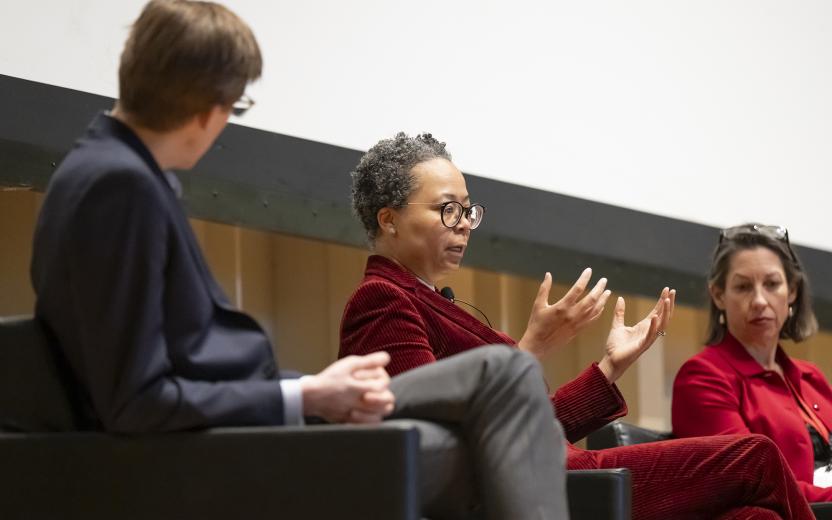
Steps from where dozens of young immigrant Jewish and Italian women leaped to their deaths when a fire erupted in the locked sweatshop where they sewed blouses, Grace Chu ’26 stood reverently in remembrance of the 146 victims of the Triangle Waist Factory fire.
She was among an estimated 2,000 people who gathered in October in Greenwich Village for the Triangle Fire Memorial dedication. The 1911 workplace disaster became a catalyst for worker protections and a defining moment for the nation.
“The Triangle Fire is such a formative event in labor history. There was no way I could not witness this commemoration,” said Chu, inspired to study labor at the ILR School after becoming aware of the fire as a high schooler. This semester, through a Jewish Studies Program course taught by Visiting Scholar and Senior Lecturer Elissa Sampson, many students are learning about the fire.
Sampson and Kheel Center archivist Steven Calco led a contingent of 60 Cornell students, faculty, staff and alums to the event. Many held 18-by-24 reproductions of fire photos from the Triangle Fire archive at the Kheel Center for Labor-Management Documentation and Archives in Catherwood Library, part of Cornell University Library and located in the ILR School.
The images provide a window into “how a tragedy can inspire collective action leading to a transformation of the nation’s labor laws. It was important for Cornell students to carry the posters as representatives of a new generation that is increasingly pro-labor, using the past as a guide for future labor action,” Calco said. “I was ecstatic to see the fire memorialized for future generations. The goal of any archive is to keep history alive and it’s rare for archivists to see the impact of the history we preserve in real time.”
Those photos stunned the nation and helped inspire generations to fight for worker protections. They were a driving force behind new New York state and federal workplace health and safety laws, many of them propelled by Frances Perkins.
A social worker who was several blocks away meeting with a friend in a city park when the fire broke out, Perkins heard the screams, ran to the site and saw workers jumping from ninth-floor windows to the sidewalk below. The New York Fire Department’s ladder was too short to reach workers in the building, now owned by New York University. In this lecture archived at the Kheel Center, Perkins recounted the experience.
Perkins served as a New York state advocate for industrial safety before becoming U.S. labor secretary and propelling New Deal policies that improved the futures of working people. Beginning in 1957, she taught at ILR for eight years. On Oct. 11, Matthew Greco ’24 held Perkins’ image throughout the commemoration. “I was unaware of how many people would be touched by it. Time after time, crowd members would compliment the poster and ask to take a picture.”
Alex Colvin, Ph.D. ’99, ILR’s Kenneth F. Kahn ’69 Dean and the Martin F. Scheinman ’75, M.S. ’76, Professor of Conflict Resolution, was among the crowd clustered at Washington Place and Green Street.
“The memorial dedication was a deeply moving event that connects us to one of the most tragic and important events in labor history. Being at the building itself was haunting, particularly as the fire engine ladder was raised to the same point as the ladders of 112 years ago that fell three stories short,” Colvin said.
“It was wonderful to hear the appreciation for the Kheel Center’s collection on the fire, how useful it is as a resource and how it keeps alive the memory of the fire for succeeding generations,” said the dean, who met with fire victim descendants at the event.
One of them was Suzanne Pred Bass, whose two great-aunts were trapped when the fire broke out. One survived, one died. Pred Bass said she was inspired by the Cornell students and dozens of other young people who attended the event. “I looked into their young faces, the same ages of so many of the Triangle workers, and felt how important it is for the next generation to carry this labor history and its relevance to today forward.”
At the corner of the building where the tragedy unfolded, a stainless steel band 12 feet above the sidewalk at a corner of the building is cut with the names and ages of the 146 victims and mirrored in a hip-level reflective panel. The memorial is the result of a 10-year campaign.
Nearby, ILR School Senior Extension Associate David Unger ’02 listened to speakers such as Acting U.S. Secretary Julie Su, Gov Kathy Hochul and New York State Labor Secretary Roberta Reardon. As they commemorated the fire’s horrors, they drew parallels to people around the world who are victimized today by deadly workplace practices. They also solicited cheers of solidarity as they noted contemporary strikes and other labor actions by autoworkers, writers, actors, teachers, and others.
Unger, the fourth generation of his family to work as a labor organizer in the textile industry, now teaches in the New York State AFL-CIO/Cornell Union Leadership Institute, based at ILR’s Worker Institute. The fire challenged the New York Fire Department to improve its equipment and building inspection processes, he said.
Sampson, speaking with Cornell students during and after the event, said, “They saw a living legacy ensue from how history lingers due to the urgent need to address a story of past injustice, and how the work of activists, families, Kheel, the ILR School and unions was critical to this happening.”
“Hearing newer and older labor activists speak about what this history meant for them today and emphasize its ongoing importance regarding immigrants, gender and worker safety, was powerful.”
This story also appeared in the ILR School’s news page.





